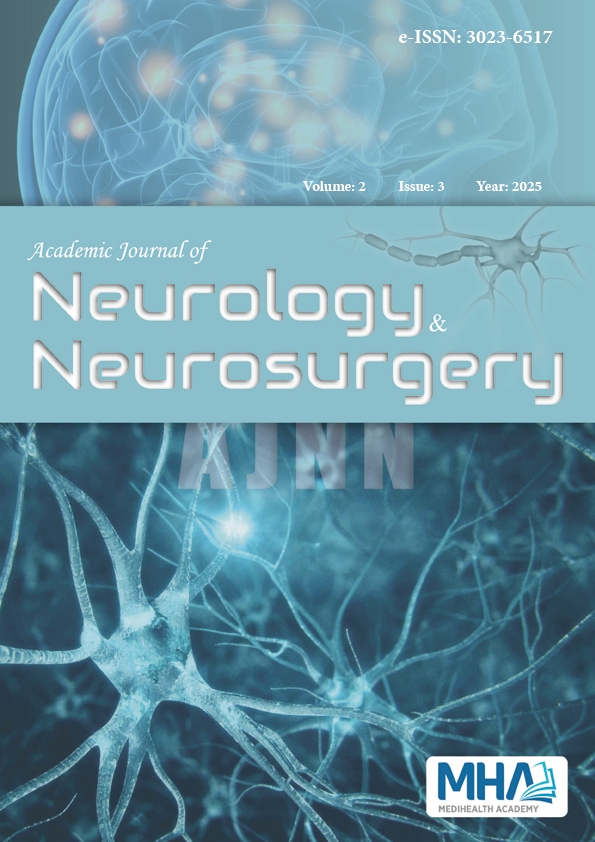1. World Health Organization. The top 10 causes of death [Internet]. Geneva: WHO; 2021 Available from: https://www.who.int/news-room/fact-sheets/detail/the-top-10-causes-of-death (cited 2025 Jul 31).
2. Murphy SL, Kochanek KD, Xu J, Heron M. National vital statistics reports. Natl Vital Stat Reports. 2015;63(9):1-117. Available from: https://pubmed.ncbi.nlm.nih.gov/26759855/ (cited 2025 Jul 31).
3. Türkiye İstatistik Kurumu (TÜİK). Ölüm ve ölüm nedeni istatistikleri, 2023. Ankara: TÜİK; 2023. Available from: https://data.tuik.gov.tr (cited 2025 Jul 31).
4. Goldstein LB, Bushnell CD, Adams RJ, et al. Guidelines for the primary prevention of stroke: a guideline for healthcare professionals from the American Heart Association/American Stroke Association. Stroke. 2011;42(2):517-584. doi:10.1161/STR.0b013e3181fcb238
5. Benjamin EJ, Muntner P, Alonso A, et al. Heart disease and stroke statistics-2019 update: a report from the American Heart Association. Circulation. 2019;139(10):e56-e528. doi:10.1161/CIR.0000000000000659
6. Powers BJ, Danus S, Grubber JM, Olsen MK, Oddone EZ, Bosworth HB. The effectiveness of personalized coronary heart disease and stroke risk communication. Am Heart J. 2011;161(4):673-680. doi:10.1016/j.ahj. 2010.12.021
7. Mendis S, Davis S, Norrving B. Organizational update: The World Health Organization Global Status Report on noncommunicable diseases 2014; One more landmark step in the combat against stroke and vascular disease. Stroke. 2015;46(5):e121-122. doi:10.1161/STROKEAHA. 115.008097
8. Powers WJ, Rabinstein AA, Ackerson T, et al. 2018 Guidelines for the early management of patients with acute ischemic stroke. Stroke. 2019; 49(3):e46-e110. doi:10.1161/STROKEAHA.119.026917
9. Pandian JD, Gall SL, Kate MP, et al. Prevention of stroke: a global perspective. Lancet 2018;392(10154):1269-1278. doi:10.1016/S0140-6736 (18)31269-8
10. Yoon SS, Heller RF, Levi C, Wiggers J, Finnegan T. Knowledge of stroke risk factors, warning symptoms, and treatment among an Australian urban population. Stroke. 2001;32(8):1926-1930. doi:10.1161/01.str.32.8.1926
11. Renjith V, Soman B, Shanmughasundaram S, et al. Stroke awareness among community health workers from rural health blocks of Thiruvananthapuram, India. J Neurosci Rural Pract. 2023;14(4):735-740. doi:10.25259/JNRP_222_2023
12. Farias DA Guarda SN, Santos JPS, et al. Realistic simulation is associated with healthcare professionals' increased self-perception of confidence in providing acute stroke care: a before-after controlled study. Arq Neuropsiquiatr. 2021;79(1):2-7. doi:10.1590/0004-282X-anp- 2019-0369
13. Ding GB, Sang Q, Han H-J, Wang X-M, Wu Y-F. Assessment of stroke knowledge and awareness among primary healthcare providers: a cross-sectional survey from the Kezhou quality improvement in acute stroke care project. Front Public Heal. 2023;11:1136170. doi:10.3389/fpubh.2023.1136170
14. Apaydın Kaya Ç, Kaya D. İnmenin önlenmesi ve tedavisinde aile hekimlerinin rolü. J Turk Family Physician. 2010;1(3):20-32.
15. Traynelis L. Emergency department nurses’ knowledge of evidence-based ischemic stroke care. Emergency. 2012;10(1):44.
16. Albart SA, Yusof Khan AHK, Abdul Rashid A, et al. Knowledge of acute stroke management and the predictors among Malaysian healthcare professionals. PeerJ. 2022;10:e13310. doi:10.7717/peerj.13310
17. Meschia JF, Bushnell C, Boden-Albala B, et al. Guidelines for the primary prevention of stroke: a statement for healthcare professionals from the American Heart Association/American Stroke Association.Stroke. 2014;45(12):3754-3832. doi:10.1161/STR.0000000000000046
18. Faiz KW, Sundseth A, Thommessen B, Rønning OM. Patient knowledge on stroke risk factors, symptoms and treatment options. Vasc Health Risk Manag. 2018:14:37-40. doi:10.2147/VHRM.S152173
19. Zarandona J, Cillero IH, Arrue M. Nursing students’ misunderstandings when learning about stroke care: a phenomenographic study. Nurse Educ Today. 2019;73:54-59. doi:10.1016/j.nedt.2018.11.013
20. Ramírez-Moreno JM, Alonso-González R, Peral-Pacheco D, Millán-Núñez MV, Aguirre-Sánchez JJ. Knowledge of stroke a study from a sex perspective. BMC Res Notes. 2015;8(1):1-8. doi:10.1186/s13104-015-1582-1
21. Perez-Lazaro C, Santos-Lasaosa S, Velazquez-Benito A, Bellosta-Diago E, Tejero-Juste C, Iniguez-Martinez C. Conocimiento de la enfermedad vascular cerebral en la poblacion de Zaragoza [Knowledge of cerebrovascular disease in the population of Zaragoza]. Rev Neurol. 2017;64(1):17-26.
22. National Center for Complementary and Integrative Health (NCCIH). Antioxidant supplements: what you need to know. 2024. Available from: https://www.nccih.nih.gov/health/antioxidant-supplements-what- you-need-to-know (cited 2025 Jul 31).
23. Zhang Y, Li Y, Liu C, et al. Vitamin E intake and risk of stroke: a meta-analysis. Br J Nutr. 2018;120(10):1181-1188. doi:10.1017/S 0007114518002647
24. Rababah JA, Al-Hammouri MM, Alnsour E. Effectiveness of an educational program on improving healthcare providers’ knowledge of acute stroke: a randomized block design study. World J Emerg Med. 2021;12(2):93-98. doi:10.5847/wjem.j.1920-8642.2021.02.002
25. Gorchs-Molist M, Solà-Muñoz S, Enjo-Perez I, et al. An online training intervention on prehospital stroke codes in catalonia to improve the knowledge, pre-notification compliance and time performance of emergency medical services professionals. Int J Environ Res Public Health. 2020;17(17):6183. doi:10.3390/ijerph17176183
26. Benjamin EJ, Muntner P, Alonso A, et al. Heart disease and stroke statistics-2019 update: a report from the American Heart Association. Circulation. 2019;139(10):e56-e528. Erratum in: Circulation. 2020; 141(2):e33. doi:10.1161/CIR.0000000000000659
27. Barzkar F, Baradaran HR, Koohpayehzadeh J. Knowledge, attitudes and practice of physicians toward evidence-based medicine: a systematic review. J Evid Based Med. 2018;11(4):246-251. doi:10.1111/jebm.12325

